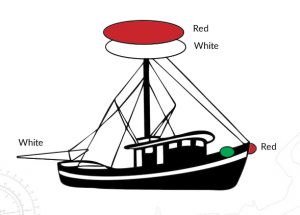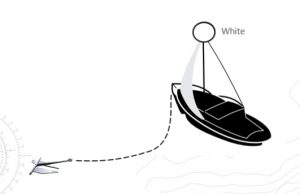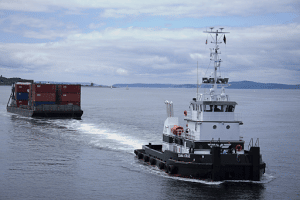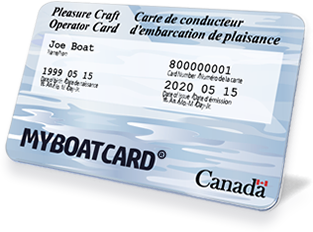Lights: Other Vessels
Fishing Boats
 Fishing Vessels are required at night to exhibit two all-round lights in a vertical line, the upper being red (green if trawling) and the lower white, or a shape consisting of two cones with their apexes together in a vertical line, one above the other.
Fishing Vessels are required at night to exhibit two all-round lights in a vertical line, the upper being red (green if trawling) and the lower white, or a shape consisting of two cones with their apexes together in a vertical line, one above the other.
You must stay well clear of all fishing vessels.
Vessel Under Oars or Paddles
Vessels under oars (such as canoes, kayaks and rowboats) without a power supply to operate navigation lights must carry a waterproof flashlight or lantern showing a white light to signal their presence to other vessels when traveling in the dark. The light must be readily available to use at any moment to prevent a collision.
Note: Small rowboats, canoes and kayaks sit very low in the water and can easily sink or capsize if swamped by large waves. If operating a powerboat, you need to slow down and be aware of the wake your boat is producing around small paddle crafts.
Vessels at Anchor
 If a vessel (including sailboats and human-powered vessels) under 50m in length is at anchor, it must display an all-round light (360 degrees) between the hours of sunset and sunrise.
If a vessel (including sailboats and human-powered vessels) under 50m in length is at anchor, it must display an all-round light (360 degrees) between the hours of sunset and sunrise.
Towboats
 When a vessel is towing or pushing and the tow is less than 200m (656 feet) from bow to stern, the tow vessel must display sidelights, a stern light, a yellow light directly above her stern light, and two masthead lights in a vertical line.
When a vessel is towing or pushing and the tow is less than 200m (656 feet) from bow to stern, the tow vessel must display sidelights, a stern light, a yellow light directly above her stern light, and two masthead lights in a vertical line.
When the tow is greater than 200m (656 feet) from bow to stern, the tow vessel shall display three masthead lights in a vertical line.
The object or vessel being towed or pushed may display a flashing yellow light in addition to standard navigation lights.
Depending on the configuration, the tow vessel and vessel(s) or object(s) being towed or pushed may be identified as a single lit vessel or separate lit vessels.
Pleasure Craft Towing Another Boat
While on the water, you may be asked to assist another boat by towing it to a safe location. When doing so it is important to make sure your boat and the boat you are towing are as visible as possible. You must display your regular navigation lights and illuminate the tow rope by using a flashlight or another light source. This will help prevent other boaters passing between the two boats and hitting the tow line.
Government or Police Vessels
A blue flashing all-round light is used by police and enforcement agencies. If you see a blue flashing light you should slow down and be prepared to stop if requested or approached by a police boat.

